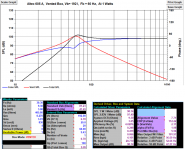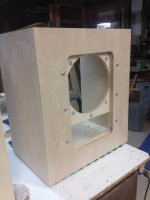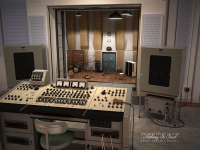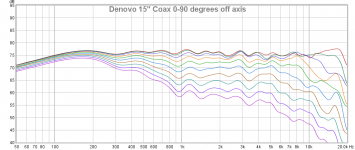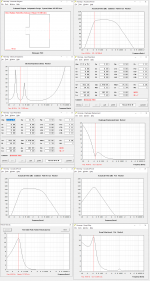I’m fairly comfortable using WinISD but on my current project, I’m trying to reverse engineer the response of an Altec 605A duplex driver in the 612 utility cabinet. In the early/mid sixties this combo was often used as a studio control room mixing monitor. I found the Thiele-Small parameters of the 605A easily enough so I was able to add it to my WinISD driver inventory. The problem arises when trying to model it in a 612 enclosure (approx 6.8ft3); the 612 is an old school cabinet with a 5.375” x 13” cut-out but no appreciable “port length” to speak of, sans the 3/4” thickness of the ply that has the cut-out.
When I model it as a vented enclosure I cannot use the cut-dimensions as a rectangular port with a 3/4” depth (the depth is ghosted). When I model it as a sealed enclosure I cannot access the Ql parameters to make it look like a “leaky” sealed cabinet. If I model it as a vented enclosure but zero out the vent dimensions, the sim kind of falls apart and gives up providing useful data.
Any pointers here?
When I model it as a vented enclosure I cannot use the cut-dimensions as a rectangular port with a 3/4” depth (the depth is ghosted). When I model it as a sealed enclosure I cannot access the Ql parameters to make it look like a “leaky” sealed cabinet. If I model it as a vented enclosure but zero out the vent dimensions, the sim kind of falls apart and gives up providing useful data.
Any pointers here?
I measured the 15” coaxial drivers I have on hand for this project. They are not the original Altec 604A but they do have the attached on/off axis response.
I measured the pair I have using DATS and averaged the measurements, creating the following T/S parameters:
Qts: 0.32
Vas: 206 l
Fs: 37.7 Hz
Re: 5.28 ohm
Le: 1.39 mH
Xmax: 6.0 mm
Qms: 10.12
Qes: 0.33
Bl: 15.68
Sd: 856.3 cm3
According to WinISD, I get I similar vented-box response to those generously modeled above with said driver in a 141.6 l cabinet tuned to 45 Hz at a vent Mach of 0.02 using a 15.3 cm diameter port 7.6 cm long.
I measured the pair I have using DATS and averaged the measurements, creating the following T/S parameters:
Qts: 0.32
Vas: 206 l
Fs: 37.7 Hz
Re: 5.28 ohm
Le: 1.39 mH
Xmax: 6.0 mm
Qms: 10.12
Qes: 0.33
Bl: 15.68
Sd: 856.3 cm3
According to WinISD, I get I similar vented-box response to those generously modeled above with said driver in a 141.6 l cabinet tuned to 45 Hz at a vent Mach of 0.02 using a 15.3 cm diameter port 7.6 cm long.
Attachments
Don't forget that in WinISD only shows one side of the story.
The total frequency response and sound also has to do with the interaction of the crossover as well as things like baffle step etc.
One could deliberately choose for a bit of an hump in the bass response to compensate for the baffle step.
Or deliberately create a dip to compensate for the DC resistance (and other effects) in the crossover filter
The total frequency response and sound also has to do with the interaction of the crossover as well as things like baffle step etc.
One could deliberately choose for a bit of an hump in the bass response to compensate for the baffle step.
Or deliberately create a dip to compensate for the DC resistance (and other effects) in the crossover filter
- Status
- This old topic is closed. If you want to reopen this topic, contact a moderator using the "Report Post" button.
- Home
- Design & Build
- Software Tools
- Help modeling “vintage” loudspeaker cabinets in WinISD
